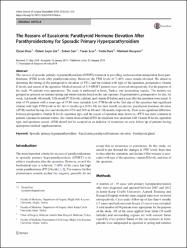The Reasons of Eucalcemic Parathyroid Hormone Elevation After Parathyroidectomy for Sporadic Primary Hyperparathyroidism
Özet
The success of sporadic primary hyperparathyroidism (SPHPT) treatment is providing normocalcemia independent from parathormone (PTH) levels after parathyroidectomy. However, the PTH levels of 7-40% cases remain elevated. We aimed to determine the timing of the postoperative elevation of PTH, and the relation with type of the operation, preoperative vitamin D levels, and season of the operation. Medical records of 119 SPHPT patients were reviewed retrospectively. For the purpose of the study, 99 patients were appropriate. The study is performed in Izmir, Turkey, and surrounding regions. The patients are grouped as operated on summer-spring and winter-autumn based on the sun exposure. On preoperative, postoperative 1st day, 1st week, 3rd month, 6th month, 12th month PTH levels, calcium, and vitamin D before and a year after the operation were noted. A total of 99 patients with a mean age of 57.88 were included. Low PTH levels in the first day of the operation had significant relation with high PTH levels in the first 6 months (p < 0.05). On the third month, eucalcemic parathyroid hormone elevation (ePTH) reached the top level and declined to 53% and 26% in 6th and 12th month, respectively. There is no significant difference between preoperative vitamin D levels, operation type, and the season of operation time; however, ePTH was more common in patients operated in autumn-winter. Our results showed that ePTH development was unrelated with vitamin D levels, operation type, and operation season. ePTH should not be accepted as an indicator of recurrence on early follow-up of patients having appropriate medical supplementation.


















